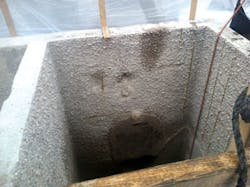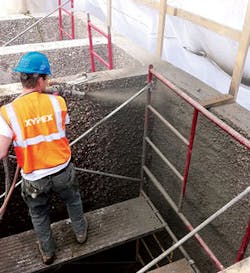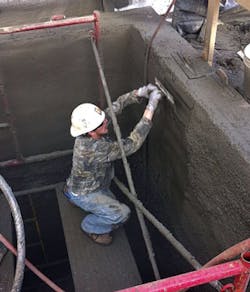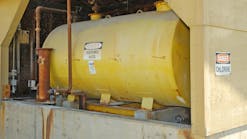| The contractor first blasted the concrete clean with high-pressure, water-based abrasive and then installed Xypex Megamix II resurfacing mortar to thicknesses ranging between 2 and 3 inches. |
Constructed around the same time as the Isle La Plume WWTP in the 1930s, the chamber once acted as a combined storm and sanitary sewer overflow structure. When the secondary aeration facility was constructed in the 1970s, the city separated the storm and sanitary flows, overflow capabilities were taken out of service, and the pipe to the slough was closed. The internal siphon chamber was then modified so that all flows were directed to the treatment plant.
Today, the more than 80-year-old siphon chamber directs about one-third of the area's wastewater flow to the nearby Isle La Plume WWTP. However, the public works agency needed a way to protect the concrete substrate.
Soon after the initial inspection, the La Crosse Department of Public Works initiated a rehabilitation project to repair the concrete chamber, replace the flow control gates and construct a bypass pumping manhole. Site work also included replacing the maintenance stairs to the chamber and re-landscaping the heavily sloped site.
Wapasha Construction of Winona, Minn., was selected to complete the performance-based contract.
Alternative Repair
The initial specification called for concrete repair and installation of a polyurethane lining system with a five-year guarantee of success. However, the team decided against the lining system because of the very damp conditions inside the chamber.
Working with the inspection contractor, Dixon Engineering, Wapasha recommended switching to a Xypex crystalline waterproofing material and resurfacing mortar that could be installed in the wet conditions found in the siphon chamber.
Xypex crystalline technology uses water in the capillary tracts as a diffusing medium to carry waterproofing chemicals into the concrete. The chemicals migrate through the waterways of the saturated pore network, where they react and grow insoluble, needle-like crystals that plug the pores. Within a few weeks of crystal growth, liquids can no longer pass through and the transmission of gases is restricted. The effect is permanent. In fact, the technology self-seals static hairline cracks up to a width of 0.4 mm, and if new cracking occurs -- even years after the original application -- the crystalline formation will reactivate to seal them.
Crystalline waterproofing has been applied on concrete water and wastewater treatment systems around the world. In all cases, the crystalline waterproofing technology is non-toxic and contains no volatile organic compounds (VOCs). This makes the crystalline material an ideal solution for applications in confined spaces.





